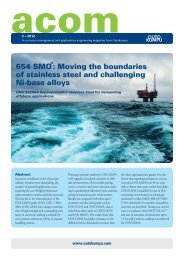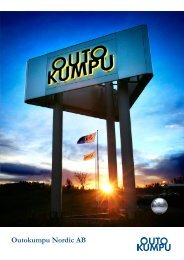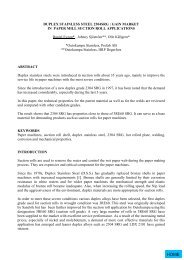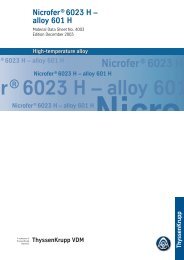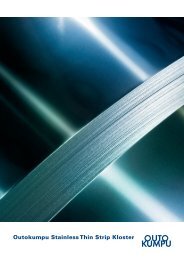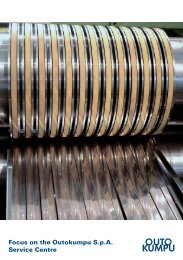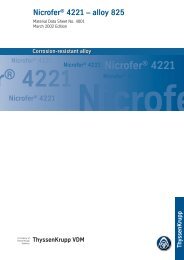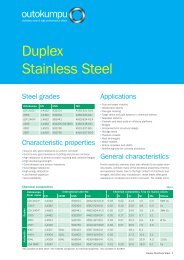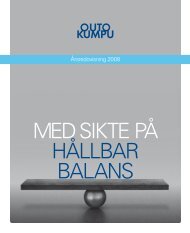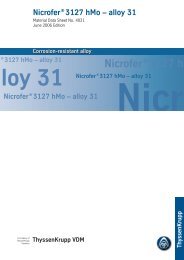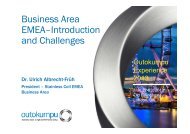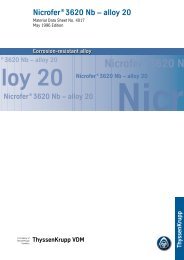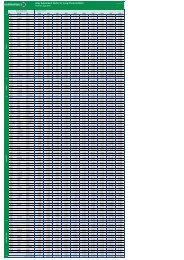Annual Report 2010 - Outokumpu
Annual Report 2010 - Outokumpu
Annual Report 2010 - Outokumpu
Create successful ePaper yourself
Turn your PDF publications into a flip-book with our unique Google optimized e-Paper software.
84<br />
Smaller amounts of rainwater fall on landfill areas located on Group sites, and this water may come into contact with<br />
alkaline wastes that could be contaminated with the hazardous compound hexavalent chromium. Such waters are<br />
treated to reduce the already-small chromium content to its naturally-occurring level, either through direct treatment in<br />
landfill areas, or by pumping the water to neutralisation plants.<br />
Paying attention to water discharges<br />
From an environmental perspective, the most significant components in water discharges from <strong>Outokumpu</strong>'s stainless<br />
steel production processes are metal compounds and nitrates resulting from the neutralisation of acidic wastes<br />
generated in the Group's cold rolling units. Effluent discharges at all of <strong>Outokumpu</strong>'s production units are controlled so as<br />
to minimise their impact on the environment. At the Tornio Works in Finland, for example, external studies conducted in<br />
the 2000s have shown that levels of metals in the primary discharges from the plant are much lower than the natural<br />
loading of metals in local rivers flowing into the Gulf of Bothnia.<br />
Developing discharge handling techniques<br />
Nitrate loadings originate in the pickling acids used in descaling operations involving stainless steel. A number of<br />
different techniques are employed by the Group to reduce nitrate loadings in effluent discharges from these operations,<br />
including pickling-acid recycling technologies. <strong>Outokumpu</strong> continues to work on the development of discharge-handling<br />
techniques to further reduce effluent loadings.<br />
At the Group's Kemi Mine, the main source of nitrates is the explosives employed in blasting – a small proportion of the<br />
explosive charges used is washed out into the facility's water-circulation system. Passage through three large ponds (a<br />
total of almost 200 hectares) located upstream of the point at which discharges into the recipient water system take place<br />
results in the nitrate content of the water being reduced by some 60%. As these water ponds are natural removal units<br />
there are no associated negative impacts on the Iso-Ruonaoja, the recipient water system.<br />
R&D to reduce discharges into water<br />
Several research projects aimed at reducing nitrate discharges into the waterways<br />
have been carried out at a number of <strong>Outokumpu</strong>'s production sites in Sweden. At<br />
Avesta, this resulted in the investment of EUR 28 million in a new acid-recycling<br />
system that was installed during <strong>2010</strong>. Process start-up is scheduled for early<br />
2011 and this method of handling acids will result in drastic reductions in the<br />
quantities of nitrates that are discharged in this location. As the new process also<br />
generates a metal oxide that can be used as a raw material in the steel melting<br />
process, the new system will also reduce the quantities of sludge sent to landfill.<br />
At the Avesta site, the oil-separation station used for purifying cooling water and<br />
rainwater has been converted into a modern lamella filter unit. Process control<br />
ensures that oil is separated from water streams. At Tornio, to further reduce<br />
concentrations of nitrogen and suspended solids, plans to use the large dredging<br />
pond near the harbour as a post-treatment area for effluents from the Works have<br />
moved forward. The basin is expected to be taken into use during the year 2011.<br />
It has also been decided that the cleaning station for sanitary waters will be renewed.<br />
Read more about the health of water ecosystems.<br />
<strong>Outokumpu</strong> <strong>Annual</strong> <strong>Report</strong> <strong>2010</strong> – Business – Water




